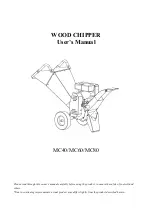
10
2 - PRELIMINARY CHECKS
2.2.2 - Siting the unit
Always refer to the chapter “Dimensions and clearances” to confirm
that there is adequate space for all connections and service
operations. For the centre of gravity coordinates, the position of
the unit mounting holes, and the weight distribution points, refer
to the certified dimensional drawing supplied with the unit.
The support points under the chassis must have at least the size
of the chassis opening at the lifting point (minimum 220 x 180 mm)
in order to prevent a deformation of the chassis.
Typical applications of these units are in refrigeration systems,
and they do not require earthquake resistance. Earthquake
resistance has not been verified.
CAUTION: Only use slings at the designated lifting points
which are marked on the unit.
Before siting the unit check that:
-
The permitted loading at the site is adequate or that
appropriate strenghtening measures have been taken.
-
The unit is installed level on an even surface (maximum
tolerance is 5 mm in both axes).
-
There is adequate space above the unit for air flow and to
ensure access to the components.
-
The number of support points is adequate and that they are
in the right places.
-
The location is not subject to flooding.
-
For outdoor installations, where heavy snowfall is likely and
long periods of sub-zero temperatures are normal, provision
has to be made to prevent snow accumulating by raising the
unit above the height of drifts normally experienced.
-
Baffles may be necessary to deflect strong winds. They must
not restrict air flow into the unit.
CAUTION: Before lifting the unit, check that all casing panels
are securely fixed in place. Lift and set down the unit with
great care. Tilting and jarring can damage the unit and impair
unit operation.
If 30XAS units are hoisted with rigging, it is advisable to protect
coils against crushing while a unit is being moved. Use struts or
spreader bar to spread the slings above the unit. Do not tilt a unit
more than 15°.
WARNING: Never push or lever on any of the enclosure panels
of the unit. Only the base of the unit frame is designed to
withstand such stresses.
2.2.3 -
Checks before system start-up
Before the start-up of the refrigeration system, the complete
installation, including the refrigeration system must be veri-fied
against the installation drawings, dimensional drawings, system
piping and instrumentation diagrams and the wiring diagrams.
During the installation test national regulations must be followed.
If no national regulation exists, paragraph 9-5 of standard EN 378
can be used as a guide.
External visual installation checks:
-
Ensure that the machine is charged with refrigerant. Verify
on the unit nameplate that the ‘fluid transported’ is R134A
and is not nitrogen.
-
Compare the complete installation with the refrigeration
system and power circuit diagrams.
-
Check that all components comply with the design
specifications.
-
Check that all protection documents and equipment provided
by the manufacturer (dimensional drawings, P&ID,
declarations etc.) to comply with the regulations are present.
-
Verify that the environmental safety and protection and
devices and arrangements provided by the manufacturer to
comply with the regulations are in place.
-
Verify that all documents for pressure containers, certifi-cates,
name plates, files, instruction manuals provided by the
manufacturer to comply with the regulations are present.
-
Verify the free passage of access and safety routes.
-
Check that ventilation in the plant room is adequate.
-
Check that refrigerant detectors are present.
-
Verify the instructions and directives to prevent the deliberate
removal of refrigerant gases that are harmful to the
environment.
-
Verify the installation of connections.
-
Verify the supports and fixing elements (materials, routing
and connection).
-
Verify the quality of welds and other joints.
-
Check the protection against mechanical damage.
-
Check the protection against heat.
-
Check the protection of moving parts.
-
Verify the accessibility for maintenance or repair and to check
the piping.
-
Verify the status of the valves.
-
Verify the quality of the thermal insulation and of the vapour
barriers.
Содержание Aquaforce 30XAS Series
Страница 2: ...2...











































